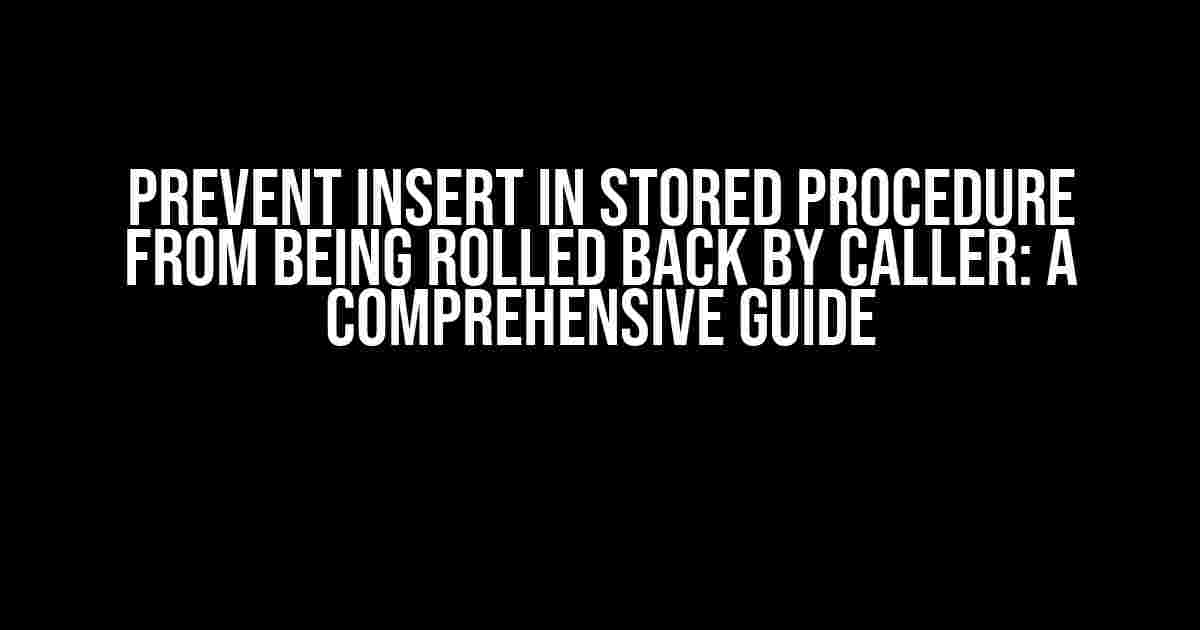If you’re a database administrator or developer, you’re likely familiar with the concept of stored procedures and transactions. However, have you ever encountered a situation where you want to ensure that certain actions within a stored procedure, such as inserts, are not rolled back by the caller? In this article, we’ll explore the reasons behind this requirement, the challenges involved, and most importantly, provide a step-by-step guide on how to prevent insert in stored procedure from being rolled back by caller.
Why Prevent Rollback?
In many scenarios, a stored procedure may perform multiple actions, including inserts, updates, and deletes. However, in some cases, you might want to guarantee that certain actions, like inserts, are persisted even if the caller rolls back the transaction. This could be due to various reasons, such as:
- Audit trail integrity: You might want to ensure that audit logs or historical records are preserved, even if the originating transaction is rolled back.
- Preventing rollback of inserts can maintain data consistency and prevent inconsistencies that might arise from partial rollbacks.
- Your application or business logic might dictate that certain actions, like inserting new records, must be persisted regardless of the caller’s transaction outcome.
The Challenge: Understanding Transaction Scope
To understand how to prevent rollback, it’s essential to grasp the concept of transaction scope and how it affects stored procedures. In SQL Server, a transaction is a sequence of operations executed as a single, all-or-nothing unit of work. When a stored procedure is called within a transaction, it becomes part of that transaction scope.
By default, any changes made within a stored procedure are rolled back if the caller rolls back the transaction. This is because the stored procedure is executed within the context of the caller’s transaction. To overcome this, we need to create a mechanism that allows us to decouple the stored procedure’s actions from the caller’s transaction scope.
Solutions to Prevent Rollback
We’ll explore two approaches to prevent insert in stored procedure from being rolled back by caller:
-
Using SAVE TRANSACTION
The SAVE TRANSACTION statement allows you to create a savepoint within a transaction. This savepoint can be used to roll back to a specific point in time, rather than rolling back the entire transaction. We can leverage this feature to create a savepoint before executing the insert statement, and then release it after the insert is completed.
CREATE PROCEDURE sp_PreventRollback AS BEGIN BEGIN TRANSACTION; SAVE TRANSACTION sp_PreventRollback_Savepoint; INSERT INTO dbo.MyTable (Column1, Column2) VALUES ('Value1', 'Value2'); RELEASE SAVE TRANSACTION sp_PreventRollback_Savepoint; COMMIT TRANSACTION; END;In this example, the savepoint is created before the insert statement. After the insert, the savepoint is released, ensuring that the changes are persisted even if the caller rolls back the transaction.
-
Using Autonomous Transactions
An autonomous transaction is a self-contained transaction that executes independently of the caller’s transaction. By creating an autonomous transaction within the stored procedure, we can decouple the insert action from the caller’s transaction scope.
CREATE PROCEDURE sp_PreventRollback AS BEGIN BEGIN TRANSACTION; EXEC sp_executesql N'INSERT INTO dbo.MyTable (Column1, Column2) VALUES (''Value1'', ''Value2''); COMMIT;'; COMMIT TRANSACTION; END;In this approach, we use the sp_executesql system stored procedure to execute the insert statement as an autonomous transaction. The COMMIT statement within the dynamic SQL ensures that the insert is persisted, regardless of the caller’s transaction outcome.
Comparison of Solutions
Both solutions have their advantages and disadvantages. Here’s a summary:
| Solution | Advantages | Disadvantages |
|---|---|---|
| SAVE TRANSACTION |
|
|
| Autonomous Transactions |
|
|
Conclusion
In conclusion, preventing insert in stored procedure from being rolled back by caller requires a deep understanding of transaction scope and the mechanisms available in SQL Server. By using SAVE TRANSACTION or autonomous transactions, you can ensure that certain actions within a stored procedure are persisted, even if the caller rolls back the transaction. Remember to weigh the advantages and disadvantages of each solution carefully, considering the specific requirements of your application and the complexity of your transactional scenarios.
By following the guidelines and examples provided in this article, you’ll be well-equipped to tackle the challenge of preventing rollback and ensuring data consistency in your database applications.
Frequently Asked Questions
Get the answers to your most pressing questions about preventing inserts in stored procedures from being rolled back by the caller!
Can I use a separate connection to prevent rollbacks?
Yes, you can create a new connection within the stored procedure to prevent rollbacks. This new connection will not be affected by the caller’s transaction, allowing the insert to commit independently. However, be cautious when using this approach, as it can lead to complex transaction management and potential issues with data consistency.
How can I use SET XACT_ABORT to prevent rollbacks?
SET XACT_ABORT ON can be used to prevent rollbacks in SQL Server. When set to ON, any error encountered during the execution of the stored procedure will terminate the transaction, and the insert will be committed. However, this approach can have unintended consequences, such as terminating the entire transaction, so use it with caution.
Can I use a TRY-CATCH block to trap errors and prevent rollbacks?
Yes, a TRY-CATCH block can be used to trap errors and prevent rollbacks. By catching the error and committing the transaction within the CATCH block, you can ensure that the insert is committed, even if the caller’s transaction is rolled back. This approach provides more control and flexibility than SET XACT_ABORT.
Is it possible to use a nested transaction to prevent rollbacks?
Yes, a nested transaction can be used to prevent rollbacks. By creating a new transaction within the stored procedure and committing it before the caller’s transaction is rolled back, you can ensure that the insert is committed. This approach requires careful management of transaction nesting and can be complex to implement.
What are the performance implications of preventing rollbacks in stored procedures?
Preventing rollbacks in stored procedures can have significant performance implications, especially if not implemented correctly. Additional connections, transactions, and error handling can introduce overhead, slow down execution, and increase resource usage. It’s essential to weigh the benefits of preventing rollbacks against the potential performance costs and consider alternative approaches that minimize performance impact.


